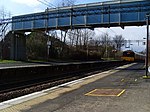Faifley

Faifley (Scottish Gaelic: Fionn Bhealach, IPA:[ˈfjuːn̴̪ˈvɛɫ̪əx]) is a large estate forming part of the town of Clydebank, Scotland, adjoining the former village of Hardgate, with a population of approximately 5,001. Along with Duntocher and Hardgate, Faifley falls within West Dunbartonshire's Kilpatrick ward with a combined population of 12,719 in 2011.Faifley has in past undergone many changes with many of the older housing removed, re-built or renovated. Faifley has two schools each with a corresponding church; Edinbarnet Primary (Non-Denominational) with the White Church and St Joseph's Primary(Roman Catholic) with St Joseph's church. At the heart of the community until now, was "Boabs", a superstore conglomerate. The community centre also contained the Faifley Branch Library until it was closed in March 2011 by West Dunbartonshire Council. Faifley Library reopened on 6 December 2013 after a decision by West Dunbartonshire Council earlier that year. The Faifley Library is located at the rear of Edinbarnet Campus, off Craigpark Street, G81 5BS.
Excerpt from the Wikipedia article Faifley (License: CC BY-SA 3.0, Authors, Images).Faifley
Faifley Road,
Geographical coordinates (GPS) Address Nearby Places Show on map
Geographical coordinates (GPS)
| Latitude | Longitude |
|---|---|
| N 55.929719 ° | E -4.392313 ° |
Address
Faifley Road
Faifley Road
G81 5BL , Parkhall
Scotland, United Kingdom
Open on Google Maps







